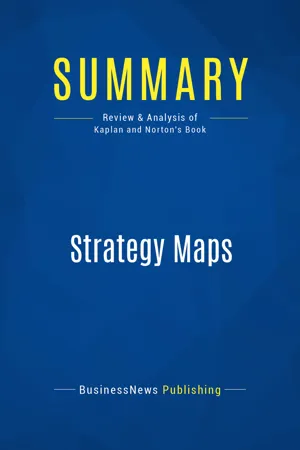
Summary: Strategy Maps
Review and Analysis of Kaplan and Norton's Book
- English
- ePUB (mobile friendly)
- Available on iOS & Android
About this book
The must-read summary of Robert S. Kaplan and David P. Norton's book: `Strategy Maps: Converting Intangible Assets into Tangible Outcomes`.
This complete summary of the ideas from Robert S. Kaplan and David P. Norton's book `Strategy Maps` shows that many businesses share the same problem: they have intangible assets that cannot be measured and counted as market value. In their book, the authors give specific guidelines on how to build an accurate strategy map in order to measure these invisible assets. By following their advice, you will be able to align all of your assets and create a coherent strategy.
Added-value of this summary:
• Save time
• Understand key concepts
• Expand your business knowledge
To learn more, read `Strategy Maps` and find out how you can create a comprehensive strategy map and become an industry leader.
Frequently asked questions
- Essential is ideal for learners and professionals who enjoy exploring a wide range of subjects. Access the Essential Library with 800,000+ trusted titles and best-sellers across business, personal growth, and the humanities. Includes unlimited reading time and Standard Read Aloud voice.
- Complete: Perfect for advanced learners and researchers needing full, unrestricted access. Unlock 1.4M+ books across hundreds of subjects, including academic and specialized titles. The Complete Plan also includes advanced features like Premium Read Aloud and Research Assistant.
Please note we cannot support devices running on iOS 13 and Android 7 or earlier. Learn more about using the app.
Information
Summary of Strategy Maps (Robert S. Kaplan and David P. Norton)
1. The Basic Template of a Strategy Map
- The desired productivity and growth outcomes.
- The customer value proposition which will be needed.
- Outstanding performance in internal processes.
- The capabilities required from intangible assets.
- The financial perspective – what financial results will be required to appear to be successful to its shareholders. This will be a balance between investing for long-term growth or cutting costs for superior short-term results.
- The customer perspective – what specific and differentiated value proposition the organization is providing its customers. In practice, there are four major value propositions:
- Lowest total cost of ownership
- Superior products or services
- Offering complete customer solutions
- System lock-in making switching difficult
- The internal perspective – the various internal processes by which products and services are prepared and delivered to customers. These can be clustered into four groups:
- Operations management – producing and delivering
- Customer management – relationship building
- Innovation – next generation products or services
- Regulatory and social – complying with the law
- The learning and growth perspective – how intangible assets (people, technology, culture) are being improved so as to enable more added value to be created in the future. Intangible assets can be divided into three categories:
- Human capital – your people
- Information capital – what you know
- Organizational capital – how you operate

- Whether to invest in intangible assets that will generate stro...
Table of contents
- Title page
- Book Presentation
- Summary of Strategy Maps (Robert S. Kaplan and David P. Norton)
- About the Summary Publisher
- Copyright